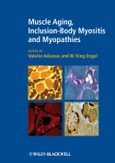Muscle Ageing, Inclusion-Body Myositis and Myopathies explores the clinical and pathological expression of muscle weakness in aging persons. Case studies demonstrate how physicians can more accurately diagnose weakening elderly patients and make better management decisions.
It also explores sporadic inclusion-body myositis and hereditary inclusion-body myopathies. The former, the most common progressive muscle disease in the over 50s, is frequently under-diagnosed and, with the increasing population of aged individuals, is presenting a greater challenge. This disease of muscle has pathological similarities with the well-known Alzheimer and Parkinson brain diseases.
Edited and written by a leading international cast of authors, Muscle Ageing, Inclusion-Body Myositis and Myopathies provides a state-of-the-art guide to ageing-associated neuromuscular disorders. It should be in the hands of all those involved in the care of aging and muscle-weakened patients.
Titles of Related Interest
Neuromuscular Disorders
Tawil and Vennance (eds); ISBN 978-0-470-65456-9
European Handbook of Neurological Management, Vol 1, 2e
Gilhus, Barnes, Brainin (eds); ISBN 978-1-4051-8533-2
European Handbook of Neurological Management, Vol 2, 2e
Gilhus, Barnes, Brainin (eds); ISBN 978-1-4051-8534-9
Table of Contents
List of Contributors, viiPreface, xi
Part 1 Muscle Aging
1 Aging of the human neuromuscular system: pathological aspects, 3
W. King Engel and Valerie Askanas
2 Aging of the human neuromuscular system: clinical considerations, 33
W. King Engel and Valerie Askanas
3 Aging of the human neuromuscular system: patient vignettes, 55
W. King Engel, Shalini Mahajan, and Valerie Askanas
4 Mitochondrial changes in aging with particular reference to muscle, and possible clinical consequences, 81
Salvatore DiMauro, Eric Schon, and Michio Hirano
5 Protein degradation in aging cells and mitochondria: relevance to the neuromuscular system, 89
Jenny K. Ngo and Kelvin J. A. Davies
6 Human muscle protein metabolism in relation to exercise and aging: potential therapeutic applications, 97
Micah J. Drummond and Blake B. Rasmussen
Part 2 Sporadic Inclusion-Body Myositis
7 Pathogenesis of sporadic inclusion-body myositis: role of aging and muscle-fiber degeneration, and accumulation of the same proteins as in Alzheimer and Parkinson brains, 111
Valerie Askanas, W. King Engel, and Anna Nogalska
8 Inflammatory and autoimmune features of inclusion-body myositis, 146
Marinos C. Dalakas
9 Sporadic inclusion-body myositis: clinical symptoms, physical findings, and diagnostic investigations, 159
Frank L. Mastaglia
10 Pathologic diagnostic criteria of sporadic inclusion-body myositis and hereditary inclusion-body myopathy muscle biopsies, 168
Valerie Askanas and W. King Engel
Part 3 Hereditary Inclusion-Body Myopathies
11 Function and mutations of the GNE gene leading to distal myopathy with rimmed vacuoles/hereditary inclusion-body myopathy, animal models, and potential treatment, 177
May Christine V. Malicdan, Satoru Noguchi, and Ichizo Nishino
12 GNE myopathy (hereditary inclusion-body myopathy/distal myopathy with rimmed vacuoles): clinical features and epidemiology, 191
Zohar Argov, Ichizo Nishino, and Ikuya Nonaka
13 Consequences of the hereditary inclusion-body myopathy-characteristic GNE mutations on muscle proteins in vivo and in vitro, 199
Aldobrando Broccolini and Massimiliano Mirabella
14 Function and structure of VCP mutations leading to inclusion-body myopathy associated with Paget disease of bone and frontotemporal dementia, 206
Cezary Wojcik
15 Clinical spectrum of VCP myopathy, Paget disease, and frontotemporal dementia: experimental models and potential treatments, 219
Virginia E. Kimonis, Eric Dec, Mallikarjun Badadani, Angele Nalbandian, Jouni Vesa, Vincent Caiozzo, Douglas Wallace, Barbara Martin, Charles Smith, and Giles D. Watts
16 Drosophila and mouse models of hereditary myopathy caused by mutations in VCP/p97, 230
Nisha M. Badders and J. Paul Taylor
Index, 241








